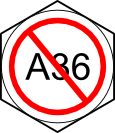
ASTM A36 is a very common steel standard that covers structural carbon steel shapes, plates and bars. Fasteners are not specifically included in the scope of A36, but that doesn’t stop engineers and contractors from asking for A36 bolts.
Why is that an issue?
The inherent problem with trying to order bolts to a ASTM steel standard, is that steel standards like A36 do not include the necessary fastener information like bolt configuration, type of or amount of threads, style of head, compatible nut or washer, acceptable coatings, etc. For example, ASTM A307, which covers low carbon general purpose bolts and studs, has the following sections detailing bolt specifics:
- Section 1.3, suitable nuts
- Section 7.1, thread geometry
- Section 7.2, head dimensions, thread length, other bolt dimensions
- Section 7.3, nut over-tapping allowances for hot dip galvanized bolts
- Section 9, test methods
- Section 13, product marking
Without these details, every mundane aspect of the fastener would need to be discussed and decided between the purchaser and the manufacturer, or assumptions would need to be made that may or may not meet the needs of the application the bolts are being used in.
ASTM A36 addresses this in the ASTM standard by including an appurtenant material chart. What this chart says is that if bolts are called out as A36, since A36 does not specifically cover bolts, then they should instead conform to the grade listed in the chart.
Below from Section 3.1 and Table 1 of A36:
When components of a steel structure are identified with this ASTM designation, but the product form is not listed in the scope of this specification, the material shall conform to one of the standards listed below unless otherwise specified by the purchaser.
| Material | ASTM Designation |
|---|---|
| Bolts | A307 Grade A |
| High Strength Bolts | A325 |
| Nuts | A563 |
| Forgings | A668 Class D |
| Anchor Bolts | F1554 Grade 36 |
| Table abridged to show only those items relevant to Portland Bolt | |
This is not to say that the materials listed above conform to or can be made from A36 steel – in many cases they cannot – simply that if the purchaser calls out a product per A36, but one that is not covered in the above scope (shapes, bars, plates), the manufacturer or supplier can supply product conforming to the above standards. For example, say someone requests A36 anchor bolts. According to this chart, those anchor bolts should be instead furnished to ASTM F1554 Grade 36. ASTM F1554 grade 36 anchor bolts are typically made from A36 or some similar low carbon raw steel, however care must be taken to make sure all the requirements of F1554 are met. Most off the floor A36 is missing the reduction of area (RA%) measurement, required by F1554, but not by A36. Additional testing may need to be performed. If, per the above chart, the anchor bolts are made per F1554, the threads, grade marking, compatible nuts, and most every other aspect and detail of the anchor bolts is already called out, saving time for both parties buy not requiring a lengthy discussion of the details, unless modifications or variances are necessary.
Portland Bolt is happy to answer questions like these or similar. We are the bolt experts; feel free to use us as a resource.
Application: All thread hanger rod to support a pipe system: What carbon steel and stainless steel fastener specification do you suggest.
@Joel- There are many ASTM standards that cover various grades of carbon, alloy, and stainless steel. For stainless steel, the two most common ASTM standards are A193 B8(304)/B8M(316) and F593 groups 1(304) and 2(316). For carbon and alloy, there are too many to list here, but our website does list many types that we stock, and has links to the chemical and mechanical properties of each so you can decide which is best for your application.
Can we use F436 washer material instead of A36 washer. Technically is it okay ?
@Karthik- F436 washers are harder and more durable than A36 washers, so whereas they are likely suitable, you always want to get approval for any substitutions from the project engineer.